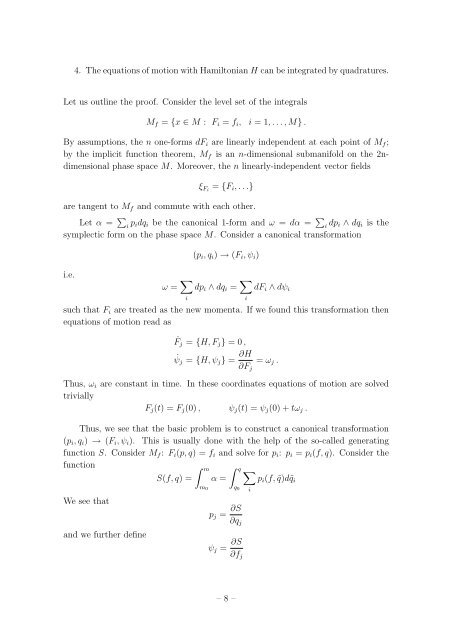Student Seminar: Classical and Quantum Integrable Systems
Student Seminar: Classical and Quantum Integrable Systems
Student Seminar: Classical and Quantum Integrable Systems
Create successful ePaper yourself
Turn your PDF publications into a flip-book with our unique Google optimized e-Paper software.
4. The equations of motion with Hamiltonian H can be integrated by quadratures.<br />
Let us outline the proof. Consider the level set of the integrals<br />
M f = {x ∈ M : F i = f i , i = 1, . . . , M} .<br />
By assumptions, the n one-forms dF i are linearly independent at each point of M f ;<br />
by the implicit function theorem, M f is an n-dimensional submanifold on the 2ndimensional<br />
phase space M. Moreover, the n linearly-independent vector fields<br />
ξ Fi = {F i , . . .}<br />
are tangent to M f <strong>and</strong> commute with each other.<br />
Let α = ∑ i p idq i be the canonical 1-form <strong>and</strong> ω = dα = ∑ i dp i ∧ dq i is the<br />
symplectic form on the phase space M. Consider a canonical transformation<br />
i.e.<br />
(p i , q i ) → (F i , ψ i )<br />
ω = ∑ i<br />
dp i ∧ dq i = ∑ i<br />
dF i ∧ dψ i<br />
such that F i are treated as the new momenta. If we found this transformation then<br />
equations of motion read as<br />
˙ F j = {H, F j } = 0 ,<br />
˙ψ j = {H, ψ j } = ∂H<br />
∂F j<br />
= ω j .<br />
Thus, ω i are constant in time. In these coordinates equations of motion are solved<br />
trivially<br />
F j (t) = F j (0) , ψ j (t) = ψ j (0) + tω j .<br />
Thus, we see that the basic problem is to construct a canonical transformation<br />
(p i , q i ) → (F i , ψ i ). This is usually done with the help of the so-called generating<br />
function S. Consider M f : F i (p, q) = f i <strong>and</strong> solve for p i : p i = p i (f, q). Consider the<br />
function<br />
We see that<br />
<strong>and</strong> we further define<br />
S(f, q) =<br />
∫ m<br />
m 0<br />
α =<br />
∫ q<br />
p j = ∂S<br />
∂q j<br />
ψ j = ∂S<br />
∂f j<br />
q 0<br />
∑<br />
i<br />
p i (f, ˜q)d˜q i<br />
– 8 –

















